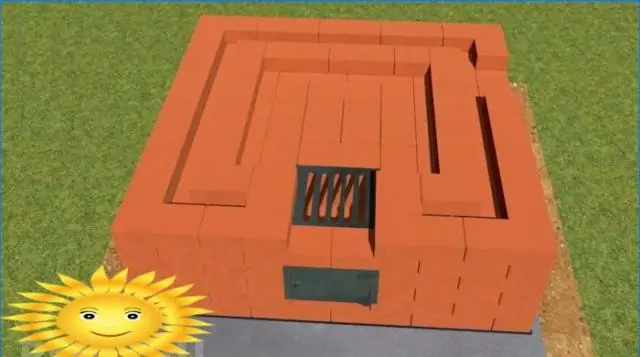
Table of contents:
- Author Bailey Albertson [email protected].
- Public 2023-12-17 12:53.
- Last modified 2025-01-23 12:41.
Do-it-yourself chimney for a bath

The stove in the bath quickly heats up the water and gives the required amount of heat, if the chimney on it is made and installed according to the rules. The chimney must ensure timely exit of the combustion products outside the premises and protect the stove from overheating. Even a hand-made pipe, which is created according to drawings after a thorough study of the chimney design and calculations, can perform these tasks without problems.
Content
- 1 Functions of the chimney in the bath
- 2 Types of chimneys
- 3 Design features
- 4 Calculation of dimensions
- 5 Required materials and tools
- 6 Requirements for the fabrication of the structure
- 7 Step-by-step guide to building a chimney with your own hands
- 8 Insulation of the chimney
- 9 Nuances of operation
- 10 Chimney cleaning
Functions of the chimney in the bath
The chimney is a vertically installed device through which fuel combustion products are removed from the combustion chamber into the environment. The functioning of the chimney is based on the creation of a draft that expels gases to the opening in the pipe outside the bath.

The stove and chimney are made of metal
A pipe mounted on a sauna stove performs certain tasks:
- removes gases, as well as smoke, soot, ash and soot, which, if the chimney is improperly manufactured, can cover its inner walls and interfere with the removal of fuel combustion products;
- generates a draft, depending on the thickness and duration of the chimney channel and formed by replacing warm air masses with cold ones.
Types of chimneys
Chimneys are divided into types, taking into account the material from which they were made. Therefore, pipes for removing fuel combustion products from the bath are:
- asbestos-cement (popular due to such characteristics as reliability, good insulation and reasonable price, but they are not always used, since they can crack under the influence of condensate and are instantly covered with soot);
- brick (they have an attractive appearance and resistance to fire, but, having an uneven surface, they accumulate a large amount of soot);
- metal (considered the most profitable option, they get very hot and therefore contribute to the speedy heating of water in the furnace tank);
- ceramic (expensive and practical, because ceramics are not afraid of intense heating, corrosion, or chemical reagents, and most importantly they are characterized by perfect smoothness).
By location, chimneys are classified into internal and external. The first view is a structure that is installed on top of the stove and rises to the ceiling, where it passes through the attic and roofing. A chimney of the second type looks like a pipe running along the outer wall of the building. It connects to the stove and immediately goes outside the bath.

The structure of the inner tube is completely vertical, and the outer tube is horizontal-vertical
The pluses of the chimney located inside the bath include:
- low fuel consumption, which is due to the fact that the combustion products passing through the pipe also provide heating of the air in the room;
- long service life, since, being indoors, the pipe does not deteriorate under the influence of adverse weather conditions.
Among the disadvantages of the inner pipe, the following should be emphasized:
- high probability of fire;
- the complexity of the work on the construction of the chimney, because it has to be carried out through the floors;
- risk of leakage of fuel combustion products into the room (if small holes form in the pipe).
The main advantages of an external chimney are:
- ease of maintenance, because the pipe outside the bath is easy to clean from dirt;
- no risk of fire.
Among the disadvantages of an external chimney are usually distinguished:
- significant consumption of firewood, since the pipe will not heat the air in the bath;
- the need for careful insulation, otherwise moisture will accumulate in the structure - the result of the combination of warm and cold air masses.
Design features
Usually the chimney looks like a structure, the horizontal position of which is observed with impeccable accuracy. But it happens that it is impossible to make the device for removing combustion products from the furnace absolutely horizontal, and therefore the craftsmen make a chimney, which is a combination of parts in position both horizontally and vertically. This design requires the addition of elbows, pipes and tees, which play the role of connecting elements.
The elbow is a connector responsible for smooth alignment of one chimney element with another. This part is used when it is required to remove a horizontal section of the structure from the stove or to direct the chimney in the other direction. When choosing a knee for arranging a chimney, you need to pay attention to the ratio of its angles, because the choice of this connector is wide enough.

Allows you to bring the chimney in the desired direction
The tee is a universal device, since it does not become an obstacle for cleaning the chimney from combustion products and ash. The tee includes a glass-shaped element that is easy to pull out and clean. The main thing is to position the tee correctly so that it connects to the pipes without any complaints. If this installation condition is not met, then the bath will smoke.

Element with three holes
A branch pipe is a connecting piece used when wooden floors are installed in a bath or other room in the attic. Installation of such an element will protect the wood from the effects of strong heat, which comes from the chimney. The branch pipe also comes in handy as a device that insulates the pipe from the materials of the roof and attic.

Chimney protective element
Another important component of the chimney design is the roof splitting. This element is responsible for creating a sealed connection between the chimney and the roof. Roof cutting protects attic floors from damage by precipitation, dirt and dust.

This chimney segment looks like a piece of pipe brazed to a sheet of metal.
Size calculation
The optimal dimensions of the chimney, calculated taking into account the volume of oxygen required to support the combustion of firewood, are presented in the table:
| Parameter | Value |
| The temperature of the combustion products at the exit from the pipe | +120 0 C |
| Maximum speed of movement of gaseous substances | From 2 m / s |
| Chimney height | 5 m |
| The weight of the fuel burned with one furnace filling | 10 kg / hour |
The chimney diameter is determined by the formula:

There should be no mistakes in determining the diameter
Vr is the volume of air.
The height of the chimney is determined based on the geometry of the section and using a special graph.

Height depends on the chimney area
The height of the chimney can be found by dividing the area of the combustion chamber (F) by the area of the chimney (f) and determining their ratio as a percentage. For example, if the ratio of the chimney section to the furnace section is 10%, then the minimum height of the round pipe will be 7 meters. For a square chimney, this value should be different - 8 meters.
Thickness is an equally important indicator. Its standard value is at least 1 mm. We are talking about the most popular option, that is, a metal chimney.
Required materials and tools
To make a chimney in a bath, you will need:
- pipes with a diameter calculated in advance;
- brackets that must fix the pipe in a certain position;
- clamps required for fixing the chimney to the wall;
- adapters with a diameter of 30 cm more than this parameter for the pipe (for connecting parts of the chimney);
- insulating material, for example, expanded clay;
- a special apron necessary for arranging the exit of the chimney to the outside;
- a cap used as the tip of the smoke duct;
- a sealant that can withstand high temperatures.
Work on the manufacture and installation of the chimney is carried out using the following tools:
- building level used to check the evenness of the structure;
- drills;
- a jigsaw, with which holes are cut in the roof and ceiling and pipes are cut to the desired size;
- screwdriver or screwdriver;
- roulette.
Requirements for the manufacture of structures

It is important to make gaps in the places where the pipe passes through the holes.
When preparing for the construction of a chimney, you need to familiarize yourself with the norms that the chimney must comply with:
- If the pipe comes out of the roof at a distance of one and a half meters from the ridge, then it is more reasonable to mount the structure at a height of 50 cm above the very top of the roof;
- When between the ridge and the chimney it turns out not less than one and a half and no more than three meters, it is more expedient to install the chimney at the same level with the chimney of the roof;
- When the ridge and pipe are more than 3 meters apart from each other, the chimney is supposed to be mounted above the dotted line, which is conventionally drawn horizontally from the highest point of the roof at an angle of 10 degrees;
- From a flat roof, only 1 meter of the chimney should go out;
- The chimney, which is one and a half meters above the roof, is certainly fixed with guy wires.
DIY step-by-step guide to building a chimney
For a home craftsman who has not gained experience in construction, it is more advisable to start making an internal chimney from metal pipes, which is led out of the ceiling and roof. The installation of such a chimney is an alternate installation of several elements, with each subsequent part being placed on top of the lower one.
Installation of an internal chimney includes the following steps:
-
The first piece of pipe is placed on the nozzle located above the stove's stove, to which a valve (gate) is added. This element is needed to adjust the draft when burning wood and finishing the furnace;

Gate of a metal chimney for a bath The gate is partially closed to keep the heat generated in the bath
-
A hole is made in the ceiling through which the chimney will go out. It is easiest to install a metal box in the created hole, which is attached to the floors so that it is level with the attic floorboards. The chimney is passed through a hole in the box, and the metal structure is covered with a layer of expanded clay or mineral wool. So that no fire occurs due to the incandescence of the metal pipe, the ceiling around the chimney is covered with asbestos sheets;

Wall and floor protection next to the chimney Attached sheets of material will prevent wood from catching fire
-
Another hole is cut in the roofing material. To create a hole in the right place - between the roof rafters - bends are used. Roofing sheets that can deteriorate when exposed to high temperatures are covered with asbestos. The metal pipe is inserted into the hole, fitted with an elastic rubber seal, and fixed in place with a flame retardant sealant;

DIY rubber seal installation P
- All the elements of the chimney, so that it reaches the desired size, are mounted, and an umbrella made of metal is put on the uppermost segment, which does not allow the chimney to be flooded with rainwater and clogged with debris. The areas where the parts of the chimney fit together are covered with sealant and pulled together with wide metal clamps.
Chimney insulation
Thinking about the insulation of the chimney, one must take into account that the heating of the pipe by the heat from burning firewood and the gases emanating from them can be very strong.

Ideal for insulating a chimney in a sauna
Therefore, it is best to use non-combustible construction raw materials as a material that protects the bath from heat loss through the chimney. We are talking about glass wool, slag concrete slabs, fiber insulation and mineral wool. The chimney must not be covered with heavy matter that retains heat.
To prevent chimney cooling, you can use ready-made heaters in the form of a cylinder. They guarantee perfect protection of the smoke exhaust duct and are equipped with a special foil shield. Thermal insulating cylindrical material is produced with different diameters, which means it is suitable for chimneys of any size.
To lay an insulating layer, you must do the following:
- wrap a metal chimney with basalt wool or other heat-insulating material about 5 cm thick;
- fix the insulation on the surface of the treasure with steel wire;
- put on a protective cover over the basalt wool and tie it on the pipe with adhesive tape.

The material is fixed and protected from moisture
Nuances of operation
The chimney will serve properly and will not be covered with a thick layer of soot, if you follow some rules when firing up the stove:
- Firewood cut from coniferous trees should not be put into the sauna stove, as they emit a large amount of resin that settles on the walls inside the chimney;
- It is not wise to heat the bathhouse with damp wood, because moisture vapor creates the same problem as resins;
- Burning garbage in a stove is a bad habit that leads to significant fouling of the chimney;
- For heating a sauna stove, it is best to harvest dry hardwood;
- The last portion of firewood used for heating a bath should be an armful of aspen wood, which burns quickly and gives a high flame, the tongues of which burn out the soot on the walls of the smoke channel;
- The chimney must be periodically cleaned so that due to soot deposits, which, when the pipe overheats, ignites and bursts out along with the smoke in the form of sparks, no fire occurs.
Chimney cleaning
When it is not possible to clean the flue duct with chemicals or the pipe lumen is heavily clogged, they resort to mechanical cleaning. It is carried out with special tools, having opened the latch in advance so that all the rubbish will fly out. Standard tools for chimney cleaning are brushes, scrapers and long-handled brushes.

A foreman in goggles uses a brush attached to a long hose
According to the rules, the removal of soot from the chimney is carried out from top to bottom. Having removed the blockages in the chimney, they begin to clean the smoke channel through the doors, not forgetting to remove deposits on the walls of the firebox and ash pan.
Dry potato peels can sometimes be used to clean the chimney. When they light up, they emit substances that make the soot loose and make it easy to remove it from the smoke channel through the cleaning holes.
The manufacture and installation of a chimney is a job that requires attention to even the smallest detail. By ignoring the requirements for the construction of a chimney, you can make the structure completely unsuitable for removing combustion products.
Recommended:
How To Make A Brick Chimney With Your Own Hands: Diagram, Device, Etc

Brick chimneys - design features, advantages and disadvantages, calculation of parameters. Step-by-step instructions for making it yourself
How To Make A Deflector (weather Vane) For A Chimney With Your Own Hands: Calculation, Drawings, Etc

How to make a deflector for a chimney with your own hands: design features, principle of operation and choice of materials, step-by-step instructions for manufacturing and operation
How To Make A Chimney From A Steel Pipe With Your Own Hands: Device, Installation Of A Sandwich Structure, Instructions With Photos And Videos

What is a steel pipe chimney, where is it used, its advantages, disadvantages and its manufacture by hand
How To Make A Chimney For A Potbelly Stove With Your Own Hands: Diagram, Calculation (including Diameter), Photo, Video, Etc

A step-by-step guide for the manufacture and installation of a chimney with your own hands for a stove. The choice of material and rules of operation
How And How To Insulate The Ceiling In The Bath With Your Own Hands Outside And Inside

Insulation of the ceiling in the bath outside and inside. The materials used, the methods used, their advantages and disadvantages. Step by step description of the process
